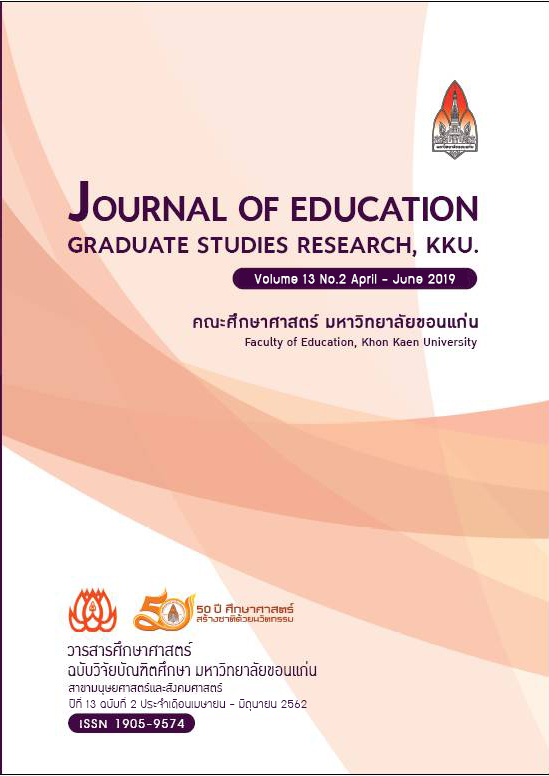THE EFFECTS OF THE COMBINATION BETWEEN EXERCISE ACTIVITIES AND BASKETBALL SKILLS TRAINING PROGRAM ON BODY MASS INDEX FAT PERCENTAGE AND PHYSICAL FITNESS IN GRADE 7 OBESE STUDENTS
Main Article Content
Abstract
The study examined the effects of short-term exercises training combined with basketball skills training program on BMI, body fat and physical fitness in obesity children. 18 obese children (boys = 5; girls = 13) aged 13 years were volunteered to participate in this quasi-experimental study. Participants
were subjected to exercises combined with basketball skills training program 3 times per week for 8 weeks. BMI, body fat and physical fitness were measured before and after 8-week training. Dependent t-test was used to determine differences of BMI, body fat and physical fitness. Significant change was reported in BMI (p<.05). Participants significantly improved in their hand grip strength, long jump and agility (p<.05), whereas no change was observed in 40-meter running speed. In conclusion, the eight-week exercise training combined with basketball skills training program contributed to improvement in the BMI and physical fitness of obesity children.
Article Details
References
กรมอนามัย กระทรวงสาธารณสุข. (2558). แนวทางการคัดกรองส่งต่อและแก้ปัญหาเด็กอ้วนกลุ่มเสี่ยงใน
สถานศึกษา สถานบริการสาธารณสุขและคลินิก DPAC. กรุงเทพฯ: องค์การสงเคราะห์ทหารผ่านศึก.
กิตติ ปรมัตถผล. (2557). หนังสือเรียนรายวิชาพื้นฐานวิชาสุขศึกษา ม.1. กรุงเทพฯ: เอมพันธ์.
ชูศักดิ์ เวชแพศย์ และกันยา ปาละวิวัธน์. (2536). สรีรวิทยาการออกกำลังกาย. พิมพ์ครั้งที่ 4. กรุงเทพฯ: ธรรกมลการพิมพ์.
เทพประสิทธิ์ กุลธวัชชัย. (2555). เทคนิคและทักษะกีฬาบาสเกตบอล. กรุงเทพฯ: โรงพิมพ์แห่งจุฬาลงกรณ์มหาวิทยาลัย.
มโน มาพะเนาว์. (2550). แบบฝึกแบบสถานี เพื่อเสริมสร้างทักษะบาสเกตบอลและสมรรถภาพทางกายสำหรับนักเรียนชั้นมัธยมศึกษาปีที่ 3. วิทยานิพนธ์ปริญญาศึกษาศาสตรมหาบัณฑิต สาขาวิชาพลศึกษา บัณฑิตวิทยาลัย มหาวิทยาลัยขอนแก่น.
วรศักดิ์ เพียรชอบ. (2525). การออกกำลังกายสำคัญไฉน. กรุงเทพฯ: ไทยวัฒนาพานิช.
สว่างจิต แซ่โง้ว. (2551). ผลการฝึกการออกกำลังกายแบบวงจรที่มีต่อสุขสมรรถนะของเด็กที่มีน้ำหนักเกิน. วิทยานิพนธ์ปริญญาวิทยาศาสตรมหาบัณฑิต สาขาวิชาวิทยาศาสตรการกีฬา บัณฑิตวิทยาลัย จุฬาลงกรณ์มหาวิทยาลัย.
อภิศิษฎ์ เสน่ห์วงศ์. (2558). ผลของการละเล่นพื้นเมืองไทยประยุกต์ที่มีผลต่อสมรรถภาพทางและ ดัชนีมวลกายกาย ของนักเรียนที่มีภาวะน้ำหนักเกิน ของโรงเรียนสาธิตมหาวิทยาลัยราชภัฏอุดรธานี. วิทยานิพนธ์ปริญญา ศึกษาศาสตรมหาบัณฑิต สาขาวิชาหลักสูตรและการสอน บัณฑิตวิทยาลัย มหาวิทยาลัยขอนแก่น.
Bar-Or, O., & Baranowski, T. (1994). Physical activity, adiposity, and obesity among adolescents. Pediatric Exercise Science, 6(1), 348–360.
Bouchard, C., Blair, S. N., & Haskell, W. L. (2007). Physical Activity and Health. 2nd ed. Champaign: Human Kinetics.
Davis, C. L., Pollock, N. K., Waller, J. L., Allison, J. D., Dennis, B. A., Bassali, R., et al. (2012). Exercise dose and diabetes risk in overweight and obese children: A randomized controlled trial. Journal of the American Medical Association, 308(1), 1103–1112.
Epstein, L. H., Coleman, K. J., & Myers, M. D. (1996). Exercise in treating obesity in children and adolescents. Medicine and Science in Sports and Exercise, 28(4), 428–435.
Faigenbaum, A. D. (2007). State of the art reviews: Resistance training for children and adolescents: Are there health outcomes? American Journal of Lifestyle Medicine, 1(3), 190–200.
Faigenbaum, A. D., Kraemer, W. J., Blimkie, C. J. R., Jeffreys I., Micheli, L. J., Nitka, M., et al. (2009). Youth resistance training: updated position statement paper from the National Strength and Conditioning Association. Journal of Strength and Conditioning Research, 23(5), S60–S79.
Kenny, W. L., Wilmore, J. H., & Hostiel, D. L. (2012). Physiology of Sport and Exercise. 5th ed.
Champaign (IL): Human Kinetics.
Lee S., Bacha F., Hannon T., Kuk J. L., Boesch C., & Arslanian, S. (2012). Effects of aerobic versus resistance exercise without caloric restriction on abdominal fat, intrahepatic lipid, and insulin sensitivity in obese adolescent boys: A randomized, controlled trial. Diabetes, 61(11), 2787–2795.
Malina R., Bouchard C., Bar-Or O., (eds). (2004) Growth, Maturation and Physical Activity. 2nd ed. Champaign, IL: Human Kinetics.
McBride, J. M., Triplett-McBride, T., Davie, A., & Newton. R. U. (2002). The effect of heavy- vs. light-load jump squats on the development of strength, power, and speed. Journal of Strength and Conditioning Research, 16(1), 75–82.
Ozmun, J. C, Mikesky, A. E., Surburg, P. (1994). Neuromuscular adaptations following prepubescent strength training. Medicine and Science in Sports and Exercise, 26(4), 510–514.
Park, J., Miyashita, M., Kwon, Y., Park, H., Kim, E., Park, J., et al. (2012). A 12-week after-school physical activity programme improves endothelial cell function in overweight and obese children: A randomized controlled study. BMC Pediatrics, 12, 111.
Shaibi, G. Q., Cruz, M. L., Ball, G. D., Weigensberg, M. J., Salem, G. J., Crespo, N. C., et al. (2006).
Effects of resistance training on insulin sensitivity in overweight Latino adolescent males. Medicine and Science in Sports and Exercise, 38(7), 1208–1215.
Vasconcellos, F., Seabra, A., Cunha, F., Montenegro, R., Penha, J., Bouskela, E., et al. (2015). Health markers in obese adolescents improved by a 12-week recreational soccer program: a randomised controlled trial. Journal of Sports Sciences, 34(6), 564–575.
World Health Organization. (2010). Population-based prevention strategies for childhood obesity: report of a WHO forum and technical meeting, Geneva, 15-17 December 2009. Geneva: World Health Organization. Retrieved March 10, 2018, from http://www.who.int/iris/handle/10665/44312
Young, W. B., McDowell, M. H., & Scarlett, B. J. (2001). Specificity of sprint and agility training methods. Journal of Strength and Conditioning Research, 15(3), 315–319.

